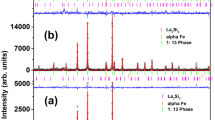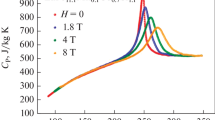Abstract
A method for calculating saturation magnetostriction values in solid-solution ternary alloys is proposed using the magnetostriction data of binary alloys implicated in the ternary system and few data of ternary alloy. Studies on three systems are presented: the Fe–Al–Si system where a considerable magnetostriction data available in the literature was employed to perform the method; the Fe–Al–Ge system in which our data are compared and discussed with a previous study in this system; and the Fe–Ge–Si system for which iso-magnetostriction curves are proposed since only one experimental value in the literature was found. The results obtained by this method approximate previously reported experimental data. This can be used to design alloys with a defined value of magnetostriction reducing the number of samples and measurements or in calculations on theoretical models. In this sense, a hypothetical behaviour of magnetostriction in the Fe–Ge binary system for Ge > 20 at.%. is also presented.










Similar content being viewed by others
References
Alves F, Lebourgeois R, Waeckerlé T (2005) Soft magnetic materials for electrical engineering: state of the art and recent advances. Eur Trans Electr Power 15:467–479. doi:10.1002/etep.70
Herzer G (2013) Modern soft magnets: amorphous and nanocrystalline materials. Acta Mater 61:718–734. doi:10.1016/j.actamat.2012.10.040
Willard MA, Daniil M (2013) Nanocrystalline Soft Magnetic Alloys Two Decades of Progress. In: Handb. Magn. Mater. Elsevier, pp 173–342
Willard MA, Claassen JC, Stroud RM et al (2002) (Ni, Fe, Co)-based nanocrystalline soft magnets with near-zero magnetostriction. IEEE Trans Magn 38:3045–3050. doi:10.1109/TMAG.2002.802435
Moya JA (2015) Improving soft magnetic properties in FINEMET-like alloys. A study. J Alloys Compd 622:635–639. doi:10.1016/j.jallcom.2014.10.124
Moya JA, Gamarra Caramella S, Marta LJ, Berejnoi C (2015) A simple method for determining the lattice parameter and chemical composition in ternary bcc-Fe rich nanocrystals. J Alloys Compd 631:99–104. doi:10.1016/j.jallcom.2015.01.014
Zukov A, González J (2006) Amorphous and nanocrystalline soft magnetic materials: tailoring of magnetic properties, Magnetoelastic and Transport Properties. In: Handb. Adv. Magn. Mater., Liu, Y., Sellmyer, D.J., and Shindo, D. Tsinghua University Press, Springer, pp 115–174
Hall RC (1960) Single-crystal magnetic anisotropy and magnetostriction studies in iron-base alloys. J Appl Phys 31:1037. doi:10.1063/1.1735741
Numakura K, Tsugawa A, Sugano M, Sato Y (1974) Magnetic and electric properties of iron-silicon alloys. Sci Rep Res Inst Tohoku Univ Ser Phys Chem Metall 24:48–60. http://ci.nii.ac.jp/naid/110004638424/en/
Takahashi M, Sato T, Kato N, Wakiyama T (1987) Magnetostriction of Fe–Si–Al (sendust) alloy sputtered films. J Magn Soc Jpn 11:303–306. doi:10.3379/jmsjmag.11.303
Hall RC (1957) Magnetostriction of aluminum-iron single crystals in the Region of 6–30 atomic percent aluminum. J Appl Phys 28:707. doi:10.1063/1.1722834
Inokuma T (1962) The magnetic properties of iron-germanium alloys. J Phys Soc Jpn 17:289–291. doi:10.1143/JPSJ.17.289
Sato Turtelli R, Bormio Nunes C, Teixeira LC et al (2009) Magnetostriction of polycrystalline Fe–Ge alloys. J Alloys Compd 471:52–55. doi:10.1016/j.jallcom.2008.03.038
Tanaka T, Takahashi M, Matsushima H et al (1989) Magnetocrystalline anisotropy and magnetostriction for Fe-(4 to 6 wt%) Si-(2 to 5 wt%) Al alloy single crystals. IEEE Transl J Magn Jpn 4:466–472. doi:10.1109/TJMJ.1989.4564035
Takahashi M, Nishimaki S, Wakiyama T (1987) Magnetocrystalline anisotropy and magnetostriction of Fe–Si–Al (Sendust) single crystals. J Magn Magn Mater 66:55–62. doi:10.1016/0304-8853(87)90128-4
Takahashi M, Arai H, Wakiyama T (1987) Magnetostriction constants for Fe–Al–Si (Sendust) single crystals with DO3 ordered structure. IEEE Trans Magn 23:3523–3525. doi:10.1109/TMAG.1987.1065759
Tsuya N, Arai KI (1979) Magnetostriction of ribbon-form amorphous and crystalline ferromagnetic alloys. J Appl Phys 50:1658. doi:10.1063/1.327229
Sato F, Ishio S, Miyazaki T (1988) Soft magnetic properties of rapidly quenched Fe–Al–M (M=Si, B, Ge) alloys. Phys Status Solidi A 107:355–363. doi:10.1002/pssa.2211070138
Bozorth RM (1961) Ferromagnetism. IEEE Press, Piscataway
Wijn HPJ (1994) Magnetic alloys for technical applications. Soft magnetic alloys, invar and elinvar alloys. Springer, Berlin
Raghavan V (2002) Al–Fe–Si (aluminum–iron–silicon). J Phase Equilibria 23:362–366. doi:10.1361/105497102770331604
Raghavan V (2002) Fe–Ge–Si (iron–germanium–silicon). J Phase Equilibria 23:443–444. doi:10.1361/105497102770331433
Noguchi S, Sato F, Sakurai T, Miyazaki T (1992) Grain diameter and magnetic properties of rapidly quenched Fe–M–Si–Ge (M=Ti, V, Zr, Nb, Ta) and Fe–Hf–Cu Alloys. IEEE Transl J Magn Jpn 7:817–823. doi:10.1109/TJMJ.1992.4565505
Acknowledgements
J.A. Moya wants to thank the MINCyT of Argentina for partially financial support under PICT-2014-2324 project.
Author information
Authors and Affiliations
Corresponding author
Ethics declarations
Conflict of interest
The authors declare that they have no conflict of interest.
Rights and permissions
About this article
Cite this article
Moya, J.A., Coisson, M. Prediction of saturation magnetostriction in solid-solution ternary alloys. J Mater Sci 52, 13227–13236 (2017). https://doi.org/10.1007/s10853-017-1405-y
Received:
Accepted:
Published:
Issue Date:
DOI: https://doi.org/10.1007/s10853-017-1405-y




